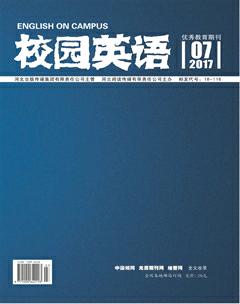中考英语模拟考试听力部分的错误分析及教学建议
徐璐
【Abstract】In order to explore the classification and factors of errors and to reduce the occurrence of errors, it is necessary to take an investigation and to make error analysis on listening component in a mock test, and then to give some feasible suggestions so as to lead the junior three students to practice more pertinently. This paper is based on an English mock test of high school entrance examination in the Chepaizi middle school of Xinjiang.
【Key words】Error analysis; listening component; English mock test
1. Definition of Error Analysis
Error Analysis (EA) is the analysis and diagnosis of errors made by the language learners, which is put forward by a pioneer in the field of Second Language Acquisition, Corder in 1970s. As a branch of applied linguistics, Error Analysis arose in 1960s and further developed in 1970s. Error Analysis is not only concerned about the error itself, but it pays more attention to the linguistic features that error reflects and the regularity in the process of Second Language Acquisition.
2. Error Analysis in Listening Test
(1) Receptive errors and expressive errors
Corder (1971) suggests that under the same language ability conditions, receptive errors involved in language use are immanent, but the expressive errors are explicit. The reasons of receptive errors are complex, the test takers can not answer correctly because they did not understand while listening, sometimes because of the confusion of the information, or they can not distinguish the right pronunciation. Expressive errors often appear in subjective test to fill in the blanks with correct words or phrases.
(2) Component errors and discourse errors
Component errors mainly indicate errors that are associated with speech sounds, grammar, vocabulary and semantics. Discourse errors indicate errors of misunderstanding of the discourse, it often made by the wrong distinguishment of speech sounds, key words, or the weakness of the knowledge of grammar.
3. The Listening Component of the Test
The test used in the study is the mock test paper of high school entrance examination for the year nine students in Chepaizi Middle School. Part I Picture Comprehension(5 points), Part II Scene Reaction(5 points), Part III Dialogue Comprehension(10 points), Part IV Passage Comprehension(10 points). Every part has five questions.
From the performance, higher error rate is appeared in item 5、6、10、14.18、20. In item 5:the question mentions two words “basketball” and “baseball”. This indicates that the test takers lack of vocabulary. The expressive error in item 6 has the highest wrong ratio. In this item, the test takers have not distinguished the differences between “What do you do?” and “How do you do?” This shows that expressive errors can be corrected through practicing the daily conversations. Component errors are because of the weakness of the knowledge of basic expressions, it reflects in item 14, some test takers cannot understand the phrase “Whats the matter?”. This requires the test takers to strengthen the knowledge of basic expressions. The discourse error in item 18 about the personal question. The sentence in the listening text mentioned two things that my classmates did for me. So there is a disturbance item about this question and many test takers choose the wrong answer.
Other reasons:(1)The disturbance of mother tongue. (2)The obstacle of cultural background knowledge. (3)The obstacle of psychological factors.
4. Suggestions
(1) Imitation training
Teachers should let students to listen to tapes, watch the video normatively, contact the normative standard pronunciation and intonation, and try to have a better language sound basis.
(2) Guiding training
The teacher instructs students listening to lectures, watch video tapes, finish preliminary understanding of the whole article in the process of listening. While guiding students to do listening training, the teacher should choose listening materials rationally. Content should be chosen from the easy to the difficult and complicated.
(3) Memory training
Repeated reading is one of the effective ways. From “listen to” go into “read” come out, the purpose is to cultivate students to remember English language information consciously.
5. Conclusion
Increasing the listening skills is a long progressive process of training. It requires the test takers to persist on practicing gradually without suspending. Teachers should improve students listening ability and result a high completion rates depend on the different situation.
References:
[1]Corder,S.P.Error Analysis and Interlanguage[M].Oxford:Oxford University Press,1981.
[2]Hughes,Arthur.Testing for Language Teachers[M].北京:外語教学与研究出版社,2000.

